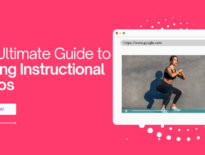Analyze and measure the impact of your explainer videos

You’ve put so much effort (and maybe a hefty budget, too) into creating the perfect explainer video content. And well, you think that paid off because your video looks amazing and tells your story beautifully.
But your job doesn’t end there. You must know if the videos are achieving the goals you’ve set out for them. So, if they’re not, you can quickly double down on your strategies. After all, you wouldn’t want to keep burning your explainer video production investment without results to show.
This explains why you need to pay attention to measuring explainer video effectiveness.
In today’s guide, I’ll walk you through why and how to measure explainer video success.
Let’s start with the basics.
What is an explainer video?
An explainer video is a concise, engaging video that simplifies complex concepts, processes, or product information. These videos typically last between 60 and 120 seconds. You can place explainer videos anywhere, including your website homepage, emails, video landing page, social media, and even product pages.
These videos can also come in various styles. In most cases, they’re often animated. But they can also be live-action, motion graphics, or a combination of these.
You can create these explainer videos yourself or opt for professional video production services to do that for you. Just consider your budget, resources, and desired level of expertise before you decide which is the right fit for you.
Why evaluate your explainer video?
No matter how top-notch you think your explainer videos are, you still need to evaluate them for various reasons. Let’s get into them.
- Lets you understand your viewership
Tracking your explainer video performance gives you better insight into who your audiences are, including their demographics and favorite content types. With this information, you can easily tailor future content to their needs. This way, you can keep your content relevant and engaging.
For example, you might discover that your audience converts better when you use animated explainer videos compared to live action. Knowing this, you may start prioritizing animated explainers in your content strategy to get the best results for your efforts.
- Helps you determine if video goals are achieved
Before launching an explainer video marketing campaign, you’d typically have a goal in mind, right? You might want to increase your brand awareness or improve your website conversion rate with your video, like 78% of businesses do. That’s great.
But to know if the video is meeting these goals, you must monitor metrics that are relevant to them. This way, you can be sure you’re not just wasting your time and money on unproductive strategies.
- Ensures you identify areas of improvement
There’s no such thing as “the perfect explainer video.” There’s always room for improvement. You’ll only discover this room for improvement when you measure explainer video effectiveness.
From your analysis, you might discover that people don’t click through to buy your product, for instance. This could mean you have to work on optimizing your calls to action. This gesture alone might lead to a drastic improvement in your conversion rates.
- Aids you in refining other marketing strategies
I just mentioned how you can use the insights from monitoring explainer video performance to refine your explainer videos. What’s even better is that you can also use these insights to improve your other marketing efforts.
For instance, you could discover that your audience prefers product process explanations to product feature enumerations. Since such content works well for your explainer videos, there’s every chance it will work well for other formats too, say “how-to” blogs. Make sure to create other types of videos that align with your brand in order to boost your marketing strategies even further.
5 essential metrics for evaluating explainer videos
Before we go into the metrics, make sure you have an analytics tool to track them in the first place. Cincopa’s powerful analytics tool allows you to do this from a single dashboard. You can get individual statistics on a per video basis. The platform also tells you other relevant details like the country where the video was viewed from, view dates, and the page where the video was played.
That said, what are the video metrics you should focus on in the first place?
1. Click-through rate
The click-through rate (CTR) is the percentage of people who clicked to watch your video after seeing it.
Suppose your video CTR isn’t improving over time. This means people are actually seeing your videos but have no reason to click and watch. There might be two reasons for this:
First, you might have placed your videos in the wrong places. Assume you placed an explainer video about heels on your male blazer product page. You probably won’t get many clicks here. Ensure you’re placing the videos where they’re relevant.
Another reason might be your video thumbnails, titles, and descriptions. You won’t get enough clicks if they don’t do a good job of grabbing potential viewers’ attention and reeling them in.
This explains why you should use high-quality and professional images for your thumbnails. Your titles should also be intriguing, clearly highlighting the value potential viewers will gain from watching. As for the description, the rule of thumb is to summarize the value viewers will be getting from the video in a few sentences.
Even better, generative AI can reduce this stress for you. AI text generator tools like Writer can handle the description and title for you, for instance. Just read a good generative AI guide to help you navigate the tool and overcome some of its limitations. Similarly, image generators like Midjourney or Bing Image Creator can help you create top-notch images for your thumbnails.
2. Conversion rate
Unless brand awareness is your only goal, you’d want your audience to click a link to perform certain actions after watching your video. This could be buying your product or signing up for your email. The conversion rate shows the percentage of your viewers who actually perform these actions.
Getting a high conversion rate in your video will depend on a few factors, starting with how persuasive your content is. Say you want your product description explainer video’s viewers to buy your product. Adding social proof by featuring footage of real users, for example, would be an excellent way to convince them.
The placement of your CTA (call to action) matters too, whether inside or outside the video. For the placement in-video, analyze your watch time (I’ll discuss this later) to see when your audience is most engaged. Ideally, your CTA should be placed within these moments.
Outside the video, you want your CTA to be prominent and placed where it’s hard to miss. This could be just below the video.
3. Social shares
Social shares are the number of times your viewers share your explainer videos on social media channels.
This metric helps you gain a better understanding of the resonance and reach of your content. After all, your viewers will only share your content if they feel it’s good enough. And the more they share, the more reach your content gets.
What could low social shares mean? First, your content might not be good enough to earn a share. To rectify this, ensure your explainer videos are loaded with insights that your audience just can’t resist. For instance, you can share expert opinions or even unique product case studies.
You can also spy on how your competitors are covering similar topics. Then, add your unique twists to produce a better version.
Low social shares could also indicate friction in the sharing process. For instance, the absence of social sharing icons for your homepage explainer videos can make it difficult for viewers to share them with their social media followers. When you take away these frictions and make things easy for your viewers, you increase your chance of getting shares.
4. View count
The view count is the total number of times people have watched your videos. So, just like social media shares, it also measures the reach your videos are getting.
Two factors affect your video’s view count:
- How many times it gets seen by potential viewers (impressions)
- Click-through rate
I’ve already explained how you can improve your click-through rate. So, let’s focus on improving your impressions.
First, use the right keywords in your descriptions. This way, whenever a target audience searches for these phrases, you’ll have a better chance of showing up.
So, use keyword tools to discover keywords your audiences are actively searching for. If you’re posting your video on a social platform, just do a quick search of your niche and the platform will give you popular related keywords. TikTok, for instance, even has a dedicated keyword insights page you can look at.
Secondly, on social media, encouraging social shares, as I mentioned before, can also earn more impressions.
As a final tip, great content can also boost your impressions. For example, if your video is so good, people will want to like, share, and watch it longer. This positive engagement can prompt algorithms on various platforms, like Instagram, to see the content as high quality. And as a result, it automatically brings it to the feeds of those who might be interested.
5. Watch time
Watch time is the average time your viewers spend watching your explainer video. A higher watch time means your audience finds your content interesting and valuable. So, content is key here too.
But interestingly, a low or stagnant watch time doesn’t necessarily mean your content is poor. It could be because you’re giving out the tea within the first few seconds. So, your viewer has no reason to complete the video.
If this rings true, consider restructuring your video to build anticipation or provide a clear reason for viewers to watch until the conclusion. For example, tease the most significant insights initially and promise more valuable content later in the video. You’d have a better chance of improving your watch time with the right pacing.
In Closing
If you’ve not been measuring the performance of your explainer videos, maybe it’s high time you started doing that. It will help you understand your audience, improve your content, evaluate your results, and even improve your other marketing strategies.
In this article, I shared five important metrics to measure explainer video effectiveness. They are click-through rate, conversion rate, view count, social shares, and watch time. I also shared some tips to enhance the results you’re getting from these video metrics. It’s up to you now to use them and drive your business growth.
Good luck with it!
About the Author
By Chris Norton, host of the UK’s 7th largest marketing podcast, which celebrates marketing mistakes, Socially Unacceptable, and Founder of award-winning B2C specialist PR agency Prohibition.










